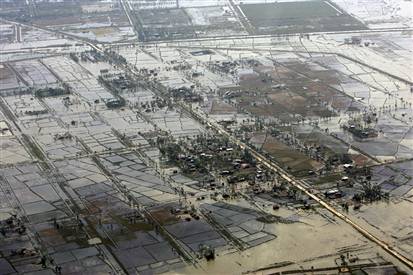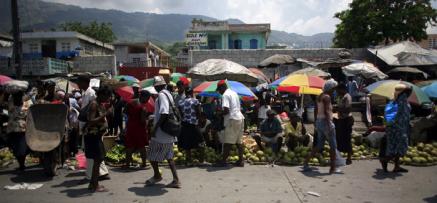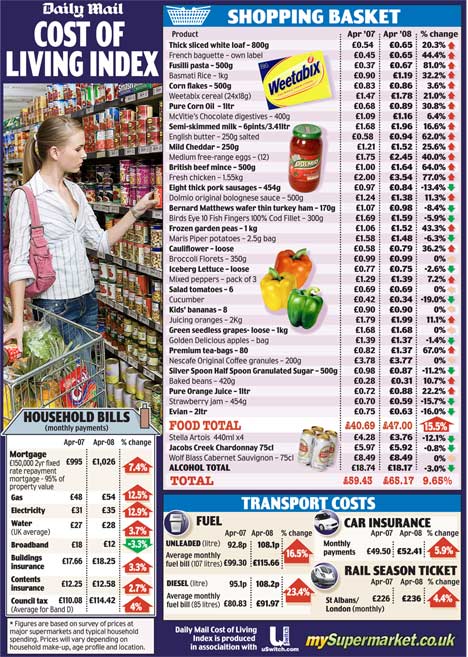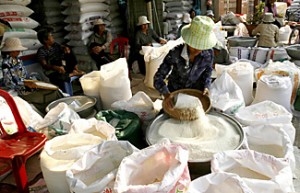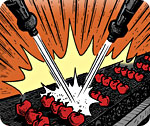
There’s a new plot underway to sterilize your food and destroy the nutritional value of fresh produce. The players in this plot are the usual suspects: The USDA (which backed the “raw” almond sterilization rules now in effect in California) and the American Chemical Society – a pro-chemical group that represents the interests of industrial chemical manufacturers. The latest push comes from USDA researchers who conducted a study to see which method more effectively killed bacteria on leafy green vegetables like spinach.
To conduct the study, they bathed the spinach in a solution contaminated with bacteria. Then, they tried to remove the bacteria using three methods: Washing, chemical spraying and irradiation. Not surprisingly, only the irradiation killed nearly 100 percent of the bacterial colonies. That’s because radiation sterilizes both the bacteria and the vegetable leaves, effectively killing the plant and destroying much of its nutritional value while it kills the bacteria.
The USDA claims this is a huge success. By using radiation on all fresh produce, they claim, the number of food-borne illness outbreaks that happen each year could be substantially reduced. It all makes sense until you realize that by destroying the nutritional value of all fresh produce sold in the United States, an irradiation policy would greatly increase the number of people killed by infections and chronic diseases that are prevented by the natural medicines found in fresh produce!
Why fresh, living produce helps prevent sickness
The USDA, you see, has zero recognition of the difference between living produce and dead produce. To uneducated government bureaucrats, pasteurized or irradiated vegetable juice is identical to fresh, raw, living vegetable juice. They believe this because they’ve never been taught about the phytonutrients, digestive enzymes and life force properties that are found in fresh foods, but that are destroyed through heat or irradiation. This, the USDA is operating out of extreme ignorance when it comes to food and nutrition.
Even a simple leaf of spinach contains hundreds of natural medicines – phytonutrients that help prevent cancer, eye diseases, nervous system disorders, heart disease and much more. Every living vegetable is a powerhouse of disease-fighting medicine: Broccoli prevents cancer, beet greens cleanse the liver, cilantro removes heavy metals, celery prevents cancer, berries prevent heart disease and dark leafy greens help prevent over a dozen serious health conditions while boosting immune function and helping prevent other infections. But when you subject these fruits and vegetables to enough radiation to kill 99.9% of the pathogens that may be hitching a ride, you also destroy many of the phytonutrients responsible for these tremendous health benefits!
This means that while irradiating food may decrease outbreaks of food-borne illnesses, it will have the unintended consequence of increasing the number of people who get sick from other infections (and chronic diseases) due to the fact that their source of natural medicine has been destroyed. For many Americans, you see, salad greens are their one remaining source for phytonutrients. Given their diets of processed foods, junk foods and cooked foods, there are very few opportunities for these consumers to get fresh, phytonutrient-rich foods into their diet. And now the USDA wants to take that away, too, by mandating the irradiation of all fresh produce.
Let me make a rather obvious prediction, on the record: If the irradiation of fresh produce goes into effect in the United States, rates of infection among consumers will sharply increase, not decrease, due to the removal of immune-boosting natural medicine from the food supply. Consumers will also experience higher rates of cancer, heart disease, dementia, eye disorders, diabetes and even obesity. By destroying these thousands of healing phytonutrients, irradiation will leave many consumers defenseless against modern society’s many health challenges.
It is no exaggeration to say that a policy of mass irradiation of fresh produce is as blatantly stupid as the Romans building their aqueducts with lead-lined waterways. As historians have explained, after the aqueducts were built, the
water delivered to the Roman population was contaminated with lead – a heavy metal that causes numerous health problems, including insanity. Many historians blame the lead-lined aqueducts as one of the primary reasons why the Roman Empire fell: Its leaders went mad, and the rest is history.
I would argue that America’s leaders are already mad, but that’s beside the point. If we start irradiating our food, thereby destroying its nutritional value, we are going to unleash a cascade of unintended consequences even greater than the Roman’s aqueducts. Absent the protections of phytonutrients found in plants, the health of most consumers will rapidly decline, and we’ll see the U.S. thrust into a quagmire of chronic disease and medical bankruptcy. (It’s already heading there, of course, but killing the food supply will only accelerate the downward spiral of health.)
Let’s sterilize all the food!
The USDA has never met a food sterilization plan it didn’t like. It backed the recent almond sterilization law that went into effect in California last year, forcing all almond growers to sterilize their almonds by subjecting them to toxic chemicals or cooking them at high enough temperatures to kill anything that might have been alive (such as the almond itself). Now, all the raw almonds consumed in America are purchased from overseas growers, where raw still means raw.
Raw milk has also been under attack in California and elsewhere. The USDA supported laws that essentially banned the sales of raw milk, requiring milk to be sterilized, too. If you now irradiate all the fresh produce, you have a food supply that is predominantly sterilized – otherwise known as “dead.” And dead foods lead to dead people.
That a society’s health regulators would want all foods to be dead should be downright shocking to anyone who knows anything about health and nutrition. Live foods keep people alive, but dead foods make people dead. It’s really not a complicated concept. The USDA’s definition of “food safety,” however, is based on the idea that the health of one immune-system-compromised individual who can’t handle a little E. Coli is more important than the ongoing health of the entire population. Thus, all foods must be killed for everyone.
I strongly disagree with this approach. Foods should not be expected to be sterilized. In terms of food safety, emphasis should be placed on boosting the health and immune systems of individuals so they can survive occasional contact with E. Coli rather than trying to create a sterile environment in which nothing is alive. As it turns out, the people susceptible to food-borne illnesses are precisely those individuals who have compromised immune systems due to their intake of vaccines and antibiotics. Thus, it is modern medicine that has made these people vulnerable to food-borne illnesses. Blame the drug companies, not the bacteria.
But the USDA would rather blame the food. Blaming conventional medicine for the harm it has caused to the human immune system is not politically correct. It’s better to blame the food, then use scare tactics to announce yet more outbreaks and hope for a public outcry for widespread food irradiation. And that brings me to the “final solution” on food irradiation.
How the USDA plans to join the FDA in keeping everyone sick
There is a corporate-sponsored plot underway in the U.S. today to keep people sick and deny them access to information about natural cures (such as medicinal foods) that would prevent disease and keep people out of the hospitals. In more than 1,500 articles on this website, I’ve documented the FDA’s criminality, the USDA’s indefensible actions, and the criminal behavior of drug manufacturers who only earn profits if they can find a way to keep the entire population sick and diseased for another generation or two.
Destroying the natural medicine in the food supply sure would be a highly effective way to create more customers for
Big Pharma, wouldn’t it? I think it’s all part of the “keep the population sick and diseased” plot being carried out by an evil partnership between drug companies and the U.S. government. We already know that the FDA and USDA work for the corporations, not the People. We already know that they will do practically anything to boost their profits (including conducting medical experiments on infants, drugging schoolchildren, lying to the public, fabricating clinical trials and more). Is it any surprise that they would now attempt a “final solution” on the food supply that kills the food and thereby results in a huge reduction in the population’s intake of the disease-fighting nutrients found in fresh produce?
The social engineering recipe
Pulling this off, of course, requires a bit of social engineering by the USDA in order to force the public into demanding something be done. If you’re the USDA, you can’t just suddenly announce a national food sterilization plan; you have to prime the pump with a bit of dirty work. Here’s the simple plan for accomplishing that, if you’re the USDA:
1) Conduct poor inspections of fresh produce on purpose, in order to cause a large increase in food-borne illness outbreaks. (We’ve seen this increase happen over the last 12 – 24 months.) This can be easily accomplished by reducing the budget of food inspection offices, or removing inspectors from the payroll altogether (which has already happened).
2) Wait for the outbreaks to happen. When consumers get sick, run national press releases announcing how dangerous the food supply is.
3) Watch the consumer reaction as people and lawmakers demand “something be done!”
4) Fudge a study with the American Chemical Society to show that washing doesn’t work and that irradiation is the only solution. Time the release of this news to coincide with the public outcry that “something be done!”
5) Once the public is demanding a solution to food-borne illnesses, roll out a national produce irradiation requirement that sterilizes all the food.
Mission accomplished! This, of course, leads to point #6:
6) Watch the population become increasingly sick and diseased (thanks to the lack of phytonutrients that used to be found in the fresh produce), and cash in on your Big Pharma shares as the population is herded into hospitals for lucrative treatments with monopoly-priced pharmaceuticals.
It’s the same old social engineering trick that’s been used to hoodwink the American people hundreds of times. How do you get the public to support a war in the Middle East? Stage an attack on U.S. soil first, and wait for the public outcry. How do you get the People to support the mass sterilization of their own food supply? Lower your inspection standards, let the sickness spread, and then wait for the public outcry. It’s the way governments get things done these days: They manipulate the public into demanding the things they wanted to accomplish in the first place. These are sometimes called “false flag operations” in a military context, and they’ve been conducted by the U.S. government on numerous occasions, just like they were conducted by Hitler in Nazi Germany to justify his invasions of neighboring countries. You can read about False Flag operations on Wikipedia: http://en.wikipedia.org/wiki/False_flag
What “they” really want: A dead food supply
Let’s be blunt about this: The corporations running this country (which also run the U.S. government) want the U.S. food supply to be dead. They don’t want foods to be used as medicines, and they sure don’t want the natural medicines found in foods competing with their own patented pharmaceutical medicines (that just happen to earn them a whole lot more money than any food ever did).
Don’t you find it curious that this attack on the food supply is coming out now, right after all this incredible news about the healing power of foods has been hitting the science journals? Every week, it seems, we find out about another amazing health property in a food. Black raspberries reverse oral cancer. Pomegranates halt prostate cancer. Green tea halts breast cancer. The list goes on. Just on this website alone, we’ve probably published 1,000 stories over the last two years on the disease-fighting properties of foods.
The thing to realize here is that many of the healing properties of these foods are destroyed through pasteurization or irradiation. If you’re a government that wants to “take away the People’s medicine,” the fastest way to accomplish that is to mandate the sterilization of the food supply. Kill the foods and you take away the People’s medicine, and that forces the population to use pharmaceuticals instead.
The FDA, for its part, has for many decades conducted its natural medicine censorship campaign, whose only purpose is to deny the People access to accurate information about the healing properties of natural medicines found in foods and herbs. But apparently that wasn’t enough: The Internet came along and people found a way to educate themselves. So since the FDA couldn’t keep the truth about natural medicine bottled up and censored, the government has now apparently decided to just sterilize all the foods, thereby destroying the natural medicine and transforming Mother Nature’s gifts into dead calories.
The USDA’s decisions here are not based on public safety, folks. They’re based on corporate greed. Just look at how they handled the raw almond controversy in these related articles: http://www.naturalnews.com/almonds.html
The USDA as operated today is a front group for wealthy corporations. It is not interested in helping the People. It’s interested in protecting the profits of corporations… even if that means destroying the food supply and turning the population into “dead eaters” who die from other diseases caused by the lack of phytonutrient protection.
How you can help stop this latest atrocity against our food supply
What can you do to stop this? Be prepared to fight irradiation plans with a massive outcry that demands our food supply be protected from radiation. There are two things that need to be accomplished, and of course the USDA and FDA oppose them both:
1) Require the labeling of all irradiated foods with a large “Irradiated” label or sticker.
2) Block any attempts to mandate the irradiation of fresh produce.
Stay tuned to NaturalNews.com for more on this story. We’ll be joining with other pro-consumer groups (like the Organic Consumers Association) to rally our readers in opposition to this food irradiation effort.
I believe we must keep our food supply fresh and alive. (Sounds kinda obvious, huh?) And if there’s a little extra bacteria on the spinach, it’s nothing that a healthy body can’t handle anyway. Take some probiotics and avoid antibiotics, and you’ll be just fine. E. Coli is really only a threat to the health of individuals who have had their immune systems (or intestinal flora) destroyed by pharmaceuticals in the first place. There’s nothing wrong with some living organisms in your milk, on your almonds or on your spinach. Wash your food, get plenty of sunlight and avoid using antibiotics.
The human body is NOT a sterile environment. To try to make our food supply sterile is insane, and anyone who supports the irradiation of the food supply is, in my opinion, supporting a policy of genocide against the American people. To destroy the vitality of the food supply is a criminal act of such immense evil that it stands alongside the worst crimes ever committed against humanity.
You see, it’s not enough for them to poison our water (fluoride), poison our children (vaccines) and lie to us about the sun (skin cancer scare stories). Now they want to destroy our foods… and thereby take away any natural medicine options that might actually keep people healthy and free. Remember: A diseased population is an enslaved population.
Now go eat your Big Mac, drink your Pepsi and don’t ask too many questions.
Monday, April 14, 2008 by: Mike Adams
###
About the author: Mike Adams is a natural health author and technology pioneer with a mission to teach personal and planetary health to the public He has authored more than 1,500 articles and dozens of reports, guides and interviews on natural health topics, reaching millions of readers with information that is saving lives and improving personal health around the world. Adams is an independent journalist with strong ethics who does not get paid to write articles about any product or company. In 2007, Adams launched EcoLEDs, a maker of energy efficient LED lights that greatly reduce CO2 emissions. He’s also a veteran of the software technology industry, having founded a personalized mass email software product used to deliver email newsletters to subscribers. Adams is currently the executive director of the Consumer Wellness Center, a 501(c)3 non-profit, and practices nature photography, Capoeira, Pilates and organic gardening.
Source: naturalnews.com

